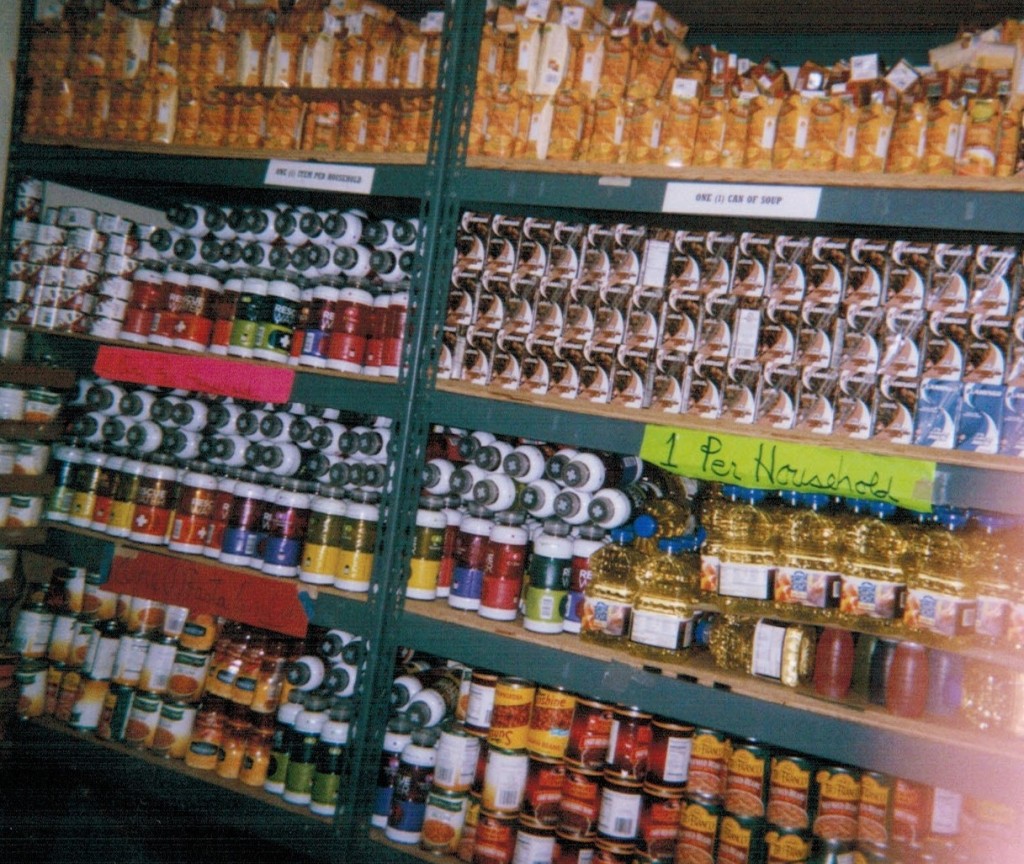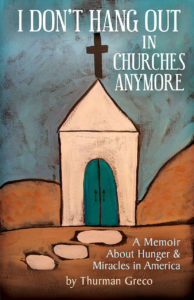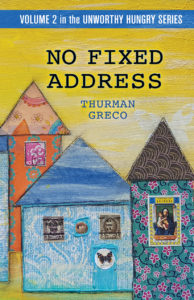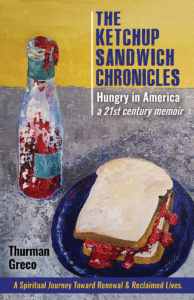“Are you closing?”
 The call came out of the blue. A pantry management person I never, ever hear from called: “Are you closing your pantry? I heard this and I’m not the kind of person to spread gossip, so I’m asking you personally.”
The call came out of the blue. A pantry management person I never, ever hear from called: “Are you closing your pantry? I heard this and I’m not the kind of person to spread gossip, so I’m asking you personally.”
“No. No, the Reservoir Food Pantry is not planning to close” I replied. Actually, I’ve been having people call me for almost a year asking if we’re closing. I always ask everyone who approaches me: ” Who did you hear this from?”
“I don’t remember, Thurman.”
“Well, I sure wish I could get someone to spill the beans because I’d love to call that person up and find out what started this whole rumor.”
If I’ve had this conversation once, I’ve had it a dozen times over the past few months. So, here for all the world to read, is the bald truth. The Reservoir Food Pantry is not closing. Actually, we’re growing like a weed.
Every Monday morning Prasida and Francine go to Latham and return with all the produce they can haul back in our long line van. They, Bob Overton, Garrett O’Dell, and Susanne Traub put it out on tables and serve it to the shoppers. By 4:00, there is usually none left. Fruits, vegetables, pies, cakes, meat, fish, yogurt, eggs, …it’s all gone.
We serve about 100 families every Monday afternoon at 2:00. On Tuesdays and Fridays we deliver food to another approximate 50 home bound households.
We have an annual mailing in which we ask the community to support us financially in our efforts.
We are at the entrances of the Kingston Walmart one weekend every month asking shoppers to help us feed the hungry.
Every other month we are at the entrance to the Boiceville IGA on a Saturday as well.
We recently opened a Capital Building account at the bank.
We are actively involved in disaster preparation activities.
The volunteers of the Reservoir Food Pantry are a group of committed individuals focused on feeding the hungry as a way of celebrating the amazing abundance which is available in our country. Only in the good old U S of A could there be this much food available…just for bringing to pantries.
We are:
your tax dollars at work.
an environmental effort as we intercept food bound for the landfill and bring it to the pantry for distribution.
working together to feed the hungry.
looking for a larger space that is located above the flood plain.
extremely grateful for the opportunity we have to feed the hungry in the Ashokan Reservoir area.
It is an honor and a pleasure for us to be in Boiceville in the little red shed behind Robert’s Auction.
Thanks for reading this blog.
Please refer this article to your preferred social media network.
I hope you found this article helpful. Please leave your comments below and check out other blog posts.
www.reflexologyforthespirit.com
www.goodmorningwoodstock.com
www.sugarsecurity.com
my.Benefits.ny.gov
Don’t forget to join the email list.
Peace and food for all.
Thurman Greco
7 Ways We Use Food Pantries
Food Pantries feed the hungry…and very successfully at that, actually. After all, there are very few stories right now about starving people dying in the streets. We Food Pantry volunteers can pat ourselves on the back for that, at least.
But, so much more happens in a Food Pantry beyond feeding the hungry.
For starters, thousands of volunteers are kept gainfully occupied and off the streets as we (wo)man the pantries.
The United States Department of Agriculture disposes of thousands and thousands of pounds of surplus foods every year in Food Pantries. Unfortunately, though, the USDA seems to have a somewhat embarrassed attitude about the distribution of agricultural surpluses. Anybody who thinks about it quickly realizes that it’s impossible to grow just exactly what we need every year. It’s much better to have too much than too little. So, the USDA needs the Food Pantries to dispose of this surplus. Sure beats hauling it off to the landfill.
Thank you USDA! I just wish you felt better about the job you do.
Supermarkets use Food Pantries to dispose of food they can’t sell. By donating produce,
baked goods,
meats,
packaged shelf staples,
grocers avoid dump fees, discourage dumpster divers, accrue tax savings, and tell the world about how many thousands of dollars they donated to feed the hungry.
Churches throughout this country feed the hungry in Food Pantries located in their basements. That is, all except for the famous St. Gregory’s Episcopal Church in San Francisco where Sara Miles put the pantry on the altar. She subsequently wrote a book about it entitled “Take This Bread”. I hope you get a chance to read it.
Congregations label their Food Pantries as outreach but I don’t buy into that concept. What we’re all doing, really, is celebrating the enormous abundance existing in this country…in this world…on this planet.
Environmentalists use Food Pantries to divert food bound for the landfill. It’s amazing when you think about it. Several million people in our country are prevented from starving to death when they shop at a Food Pantry and take home produce, dairy products, meats, baked goods, shelf staples that would otherwise have ended up at the landfill.
Schools throughout our fair nation distribute food to children to take home on the weekend. The Backpack Programs offer food to children who have none in their households.
It’s a real ego trip for whole segments of our society. Everyone feels all warm and fuzzy about food donated to Food Banks. This includes farmers, grocers, food manufacturers, restaurants, bakers, religious and civic institutions feeding the hungry, and, of course, the people who read the stories about the generosity of these businesses.
This warm and fuzzy feeling we all get when we realize which businesses are contributing to feeding the hungry rubs off positively on Food Banks. They, thankfully, are very influential charities as a result. Food Banks rank right up there with hospitals, the United Way, and the Y.
And, it’s all good. Food Banks need the $$$ to keep the whole industry going. The demand for the food keeps growing and growing because the minimum wage jobs don’t pay enough $$$ to allow workers to buy groceries. SNAP benefits get whittled away each year. There’s not much left except the Food Pantry.
Thank you for reading this blog/book.
Please send a comment.
Please refer this article to your preferred social media network.
Don’t forget to join the email list.
http://teamnutrition.usda.gov
www.feedingamerica.org/officialsite
www.reservoirfoodpantry.org
Thurman Greco
I Have a Question


“When I drive down Route 28 on Monday, I see a lot of cars at your pantry. I see many people. I have some food pantry questions. Are they from our area?”
My answer: “Yes, they are from our area.”
But, that’s not the right question and it’s certainly not the right answer. The correct answer is that we serve everyone who manages to make it to our pantry…no matter where they’re from.
In our country now, in the U. S. of A., we have people who are hungry. Many of these people work. Many hold down 2-3 minimum wage jobs. Even with these jobs, their minimum wage pay checks don’t have any $$$ for food. So, they come to a pantry for food.
They come to the pantry they can get to…not the one in their neighborhood. And, the reason for that makes a lot of sense. If they live off Route 28 but work in Cairo on Monday, they’ll never make it to the Boiceville pantry on Monday before it closes.
When I worked in the Good Neighbor Food Pantry in Woodstock, there was a volunteer who didn’t agree with this philosophy. A hungry man from Shandaken got a ride into Woodstock and stood in line for food.
The volunteer denied him food. He went away hungry. He came to Woodstock for food because he didn’t have a car and his ride brought him to Woodstock.
Pantries serve the people who can make it to their pantry. At Reservoir Food Pantry we also serve food to home bound households where the residents are transportation challenged.
It’s not where the hungry live that determines what pantry they use. It’s what pantry they can get to.
Food pantries and soup kitchens are our tax dollars at work. The government has decided the hungry should not starve to death. The government has chosen food pantries, soup kitchens, shelters, and halfway houses as places for the hungry to get food.
We don’t ask the address of any of the hungry in our line. Nor do we care.
Our job is plain and simple: to feed the hungry.
For the most part, the food that we serve is food that was destined for the landfill. Most pantry volunteers are just that…unpaid workers concerned about our neighbors, relatives, friends who are not getting enough to eat.
Thank you for reading this blog/book.
Please share this article with your preferred social media network.
I hope you found this article helpful. Please leave your comments below and check out our other posts.
Don’t forget to join the email list.
Are you working but having a hard time making ends meet? Check your eligibility for a range of benefits and apply for food assistance at:
myBenefits.ny.gov
I hope you found this article helpful. Please leave your comments below ad check out our other posts.
Please refer this article to your preferred social media network.
Don’t forget to join the email list.
Peace and food for all.
Thurman Greco
8 Ways the Hungry Get Food.
Betty and her daughter are Woodstock born. They’ve shopped there regularly since the Good Neighbor Food Pantry opened and began feeding the hungry.
For years, they shopped at the pantry, CVS, Rite Aid, and Woodstock Meats between periodic trips to Walmart in Kingston. Then, several years ago, Betty’s husband died and trips to Walmart ceased to be part of the routine. It became a luxury for them when a relative invited them to ride along to Kingston to shop.
Finally, he died too, and now Betty and her daughter have no transportation to Kingston. They’re eating out of the pantry and CVS.
The combination of limited income, no access to affordable grocery stores, and no automobile makes life difficult for the 2 women. Although she probably qualifies, Betty has never gotten SNAP.
There are many people in a situation similar to Betty and her daughter. People in Betty’s situation learn to cope with lack of access to food and the complications created by a limited budget and no automobile. They
get SNAP if they can.
dumpster dive.
shoplift.
ask friends and relatives for food.
borrow $$$ for food from friends and relatives.
visit a friend or relative at mealtime.
go to the soup kitchen.
shop at a pantry.
Betty is a single senior living with an adult daughter. Life is a bit more complicated with young children in the household when there’s not enough food and no $$$. Households develop coping mechanisms to deal with the situation.
One such technique consists of simply serving less food.
Another consists of just skipping meals.
A third is to feed children what is available and adults go without.
But, whether the household has adult children, younger children, or no children at all, hunger is a reality for people in this situation. They are classified as either being at risk of hunger, or experiencing hunger depending on the severity of the situation.
Whatever the classification, one thing is certain:
People in this situation are intimately connected to hunger on a daily basis.
They are also a good example of the reality that in this country we have 2 food systems:
one for the poor and
one for everyone else.
Thank you for reading this book/blog.
Please send a comment.
Please refer this article to your preferred social media network.
Don’t forget to join the email list.
Peace and food for all.
Thurman Greco
Can we break down the barriers?
 Starving seniors? Is that too harsh a term?
Starving seniors? Is that too harsh a term?
Let’s ratchet it down: hungry
Or maybe: food insecure. Yeah, that’s better. It sounds better anyway.
Call it what you want, the event is the same. It’s your grandmother or grandfather (for me…I’m certainly a grandmother) caught in a situation where there’s simply not enough food in the house.
MANY OF OUR OLDER RELATIVES QUIETLY CHOOSE BETWEEN BUYING MEDICATIONS OR PUTTING FOOD ON THE TABLE.
The issues with seniors and food insecurity are serious because when seniors no longer have the $$$ to buy the food they need for proper nutrition or when they can no longer pay for the medications they need, they become ill and finally end up being taken care of by their children or they end up in a nursing home.
I know stories about:
The older Woodstock woman living on mashed potatoes.
The woman who ended up in a nursing home when she was cut off from her take out food and didn’t have the resources or physical ability to get to a grocery store.
The older man who lacks funds for enough food and is slowly starving to death.
THERE IS FOOD AVAILABLE FOR SENIORS:
IF they can get to a pantry or connect with a pantry offering take out
IF they will sign up for SNAP (food stamps).
I was recently speaking with a retired man I know:
“Richard, do you get SNAP?”
“No.”
“Why, Richard? SNAP is usually easy to get. All you have to do is apply.”
“Well, I’m getting by alright without it. Let someone else, needier than me, get the $$$.”
“Richard, think about getting SNAP. This is a benefit you paid for. This $$$ is waiting on the table for you. You’re not the kind of guy who leaves $$$ on the table.”
I HAVEN’T CONVINCED HIM YET. However, we’re not through negotiating. As seniors, we’re in a situation where every little bit helps.
THE BARRIERS SENIORS PUT UP TO SNAP ARE GREAT. Seniors resist going to a pantry, soup kitchen, getting SNAP until they simply cannot resist any longer. I know the feeling. We grew up as children and went into adulthood feeling that if we worked hard and paid our taxes, we would end up okay. We worked all our lives with this event in sight and now that we’re here…there simply isn’t enough.
With this event comes the feeling of inadequacy and the self blame. “I must have done something wrong. Here I am living hand-to-mouth. I don’t even have enough $$$ for food. What did I do wrong?”
THERE’S SOMETHING WRONG WHEN A WHOLE GENERATION OF PEOPLE BEGIN BLAMING THEMSELVES. We’re really not totally to blame. The rules have changed. Because we’re retired, we’re not in the rules making game anymore. Retirees by their very nature are disempowered. Whatever happened to the Gray Panthers?
FOOD INSECURITY AMONG SENIORS IS AN EPIDEMIC. People work on both a state and national level to make SNAP more available to seniors. The least we can do is get a card and use it.
Thanks for reading this blog/book.
Please send a comment.
Please refer this article to your preferred social media network.
Don’t forget to join the mailing list.
Peace and food for all.
Thurman Greco
JSY…What’s that? Nutritionist Education!

Although we see her only once a month, everyone knows when she’s coming and they gather in the Community Room at Woodstock Commons early to be sure a get a good spot for her presentation. Amy is one of the pantry’s favorite people.
So, who is Amy Robillard and what makes her so fancy anyway?
Amy is the Just Say Yes nutritionist from the Food Bank of the Hudson Valley of New York State.
Food pantries, soup kitchens, and emergency shelters, through the Food Bank of the Hudson Valley offers nutritionist education, a service to our shoppers: a nutritionist who gives talks along with cooking demonstrations to the shoppers.
Although some people feel like this is a luxury that poverty stricken people shouldn’t have, I feel strongly that the food pantry nutritionist education is a necessity, not a luxury. Amy gives classes in cooking and serving fruits and vegetables. Very often the shoppers in the pantry line take home foods that they’ve never seen before, do not know the name of, and have no idea how to prepare and eat.
Amy teaches simple and affordable ways to eat more fruits and vegetables. She makes learning about nutrition and food safety both fun and easy to understand. Amy has a series of 11 different lessons that she shares over the course of a year. During this time, she will share over 100 different recipes which are low cost, easy to prepare, and delicious.
With Amy’s information, nutritionist education, and encouraging attitude, the shoppers take new foods home with them each week which they feed to their families. This is an important part of the pantry shopping experience.
Often, the new shopper has lived on less than 10 foods for his/her entire life. It is not unheard of to speak to people who have lived on beans, bread, and greens their entire lives.
To visit with a shopper after a year of shopping in the pantry is to interact with a totally new person. The experienced pantry shopper knows much about foods:
their nutritional value
their origin
how to prepare them.
We begin to notice changes in a pantry shopper within 6 weeks of the first visit. The very first changes we see are a straighter back, a more confident walk, clearer skin, smiles. People look better, walk better, and interact better socially when they are no longer afraid of living with hunger.
Amy helps facilitate this. She teaches them how to cook with pantry food. She makes them feel at ease at the pantry. She normalizes a hidden, stressful experience as she removes the negativity. .
I wish all pantries had a nutritionist on board.
Reservoir Food Pantry is happy to have Amy come visit whenever she can. We’re grateful to be on her schedule.
Thanks for reading this blog/book.
Please refer this article to your preferred social media network.
I hope you found this article helpful. Please leave your comments below and check out the other posts.
Don’t forget to join our email list.
Peace and food for all.
Thurman Greco
Walmart and the Minimum Wage
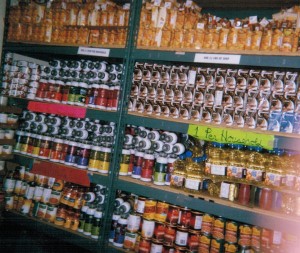
As the country’s largest employer, Walmart gets criticized for many “wrongs” not exclusive to itself.
Although retailers throughout our country only pay minimum wages, people act like Walmart is the only one. They pretend the other retailers pay over $10 per hour and include wonderful benefits like health care and retirement.
Wrong!
Most retailers pay what Walmart pays – maybe even a little less. In our own Woodstock area, retailers not only pay less, they often pay their sales employees off the books.
So, the recent news of Walmart and the minimum wage hourly rate increases to $9 per hour is an excuse to celebrate, if nothing else. Walmart is a trendsetter! Hopefully this move will motivate other retailers to do the same.
Those of us who work in pantries fantasize we’ll have fewer people in our lines. In some locales, I’m sure that may be true.
However, I harbor no fantasies. For one thing, the people in our pantry line are mostly senior citizens too old to work. For another, those young enough to hold down jobs work for companies who aren’t going to raise the wages.
Over the past few decades, we’ve created a food system for the poor. The more affluent in our country shop in super markets. Everyone else shops at the convenience store, pharmacy grocery aisle, the food pantry.
Because of the situation created in recent years by food deserts, the underemployed or unemployed poor struggle to get enough food to eat while also trying to get the right kinds of nutritious foods needed to stay healthy.
Over the years, food manufacturers, farmers, grocers, corporations, foundations, individuals, and the government work together to provide surplus food to feed those in need.
The goal: give food assistance to the hungry.
Since 2006, the need for emergency food has morphed into an ongoing need for food for people from all walks of life.
The new paradigm is to feed them nutritious food regularly because these people can no longer buy the food to feed themselves.
Many find themselves in this position for the first time in their lives. There are now men, women, and children needing assistance to alleviate hunger in every county in every state in the union, as well as the District of Columbia.
High unemployment/underemployment, increasing housing costs, rising poverty, the rising cost of fuel to heat apartments and homes, increasing transportation costs, and the escalating cost of food make emergency food assistance become supplemental food assistance.
Financial safety nets disappear as congress repeatedly cuts benefits.
Today’s pervasive hunger undermines our communities, schools, work force, and national security.
When people don’t have enough food to eat today, it’s impossible to plan for tomorrow. People with enough to eat work better and learn better. They can build a better life for themselves and their families.
This is what Walmart raising the minimum wage is all about.
Raising the minimum wage a few cents or dollars is not about solving the problems of poverty. It’s about feeding the hungry.
Thank you Walmart, and every other employer in our country who pays workers a living wage. You are to be commended. Hopefully this will start a trend toward employers everywhere paying living wages to workers.
Thanks for reading this blog/book.
Please send this article to your preferred social media network.
I hope you found this article helpful. Please leave your comments below and check out our other posts.
Don’t forget to join the email list.
Peace and food for all.
Thurman Greco
Is This Life Now?

The New York Times – Friday, February 27, 2015 – “Food Waste Grows with the Middle Class” – page A24
A recent New York Times Editorial highlighted the “massive food waste” around the world. I urge you to read it. It was extremely well written, as are all of the NYT editorials.
Containing all the right buzz words:
landfills,
hunger,
waste disposal,
global warming threat,
it just didn’t go far enough.
FOOD PANTRIES FEED THEIR CLIENTS SURPLUS FOOD INTERCEPTED ON ITS WAY TO THE LANDFILL. They simply no longer have the $$$ for food at the supermarket or they live in food deserts (neighborhoods where there are no grocery stores or supermarkets.)
Is this life now? Yes, this is life in 21st century America. This is not emergency food. This is the new way we live in the good old U S of A.
PEOPLE ARE OFTEN ASHAMED TO SHOP IN PANTRIES. They don’t want to be seen bringing pantry food home. They don’t want to explain to their friends, neighbors, relatives about their inability to buy food at the supermarket. Well, now they can move on past the shame and embarrassment. With this New York Times editorial, we can all see that hungry people lacking $$$ to purchase food at a grocery store are now a part of the solution instead of the problem.
Hungry people shopping at food pantries help fight food waste. Food pantry shoppers can now realize they are helping reduce global warming emissions.
People shopping at pantries are in a financial bind where they are forced to make trade-offs. They pay rent when they don’t have enough food to eat. They “heat or eat”.
Often, they make health care trade-offs. People unable to seek needed medical care are unable to make good choices. Eventually they’ll be forced to deal with the medical situation and the longer they wait, the more expensive the situation becomes. The healthcare $$$ has been diverted to rent or transportation to get to work.
Articles like the New York Times editorial make it difficult for citizens in our country to completely ignore the fact that more and more people are going without food in our great nation because they simply don’t have the $$$ to buy it. We can no longer deny that hunger exists and it is becoming more and more difficult to be indifferent about it.
So, now, with this editorial, those of us who are hungry and ashamed of the situation we are caught in can feel better about ourselves. We can now shop at the pantry and eat at the soup kitchen knowing that we are, in spite of the low wages we work for, doing our part for a healthy planet. We are fighting global warming. We are our tax dollars at work.
If you read this blog and feel you are among those who don’t have enough $$$ for food, now is a good time to begin to shop at a pantry for the food you need for your household.
There is no better time than now for you to not only support your community but also your planet.
See you at the pantry!
Thank you for reading this blog.
Please refer this article to your preferred social media network.
If you found this article a help, please leave your comments below and check out our other posts.
Don’t forget to join the email list.
Peace and food for all.
Thurman Greco
Are You Afraid in the Pantry ?
“Are you ever afraid in the pantry?” the woman asked. She was at a talk I gave about hunger. “No.” I answered. “Never. Not in the pantry. The pantry is a safe haven.”
But, I did understand her question. It went much deeper than fear in the pantry. This woman was reaching out. We live in perilous times. ISIS, police, illness, hurricanes, rapists, purse snatchers, you name it. Danger appears to be everywhere around us.
Many, many people live in fear. Many of those are afraid to voice their fears.
When I write about specific health issues on my reflexology blog, fear is almost always a factor.
Well, there are things we can all do to cope. There’s no need to live a life feeling vulnerable.
For starters, we can protect ourselves. I practice several different forms of protection.
Prayer
Meditation
Visualizations
Preparation
Every Saturday morning, promptly at 9:30, I can be found entering the Fitness Connection in Kingston where I study self defense under trainer Paul LaCroix. I’m there for an hour each week learning finger jabs, wrist escapes, double wrist escapes, elbow smashes, kicks, bear hug escapes, and ground defense techniques. Paul teaches new things every week. Basically, he’s teaching me that my elbows and knees are weapons to be used in case of attack or assault……
Paul’s classes are a lot more fun than doing repetitions in a gym, that’s for sure. And, the added bonus is that I feel as if I’m prepared for an unknown assailant.
And, of course, I feel as if I’m going to be a bit of a surprise for anyone who thinks that as a 70+ year old cotton top, I’ll be an easy mark.
I’ll be blogging more in the future about self protection techniques. We all need these tools because it’s important to feel safe both physically and spiritually.
In the meantime, you’re invited to join Paul’s Saturday morning class. It’s ongoing and it’s adaptable to different age, strength, and skill level.
See you there!
SNAP and Seniors: Many just don’t get it.

Please share this post with any and all seniors you may know. Chances are they might be able to use the information…especially since 1 senior in 7 in our country doesn’t get enough to eat.
Seniors are extremely reluctant to use SNAP, partly because of myths surrounding SNAP.
SNAP Myth #1:
Why apply for SNAP? It’s not worth the hassle. I may not even get much $$$.
SNAP Reality #1:
Most people get more than just a few dollars. Some families receive over $100. But, whatever you get – it all adds up, Over time, you’re going to receive several hundred dollars annually. This $ is yours.
Whether it’s $16 or $160 is not the issue here. This is $$$ that you paid taxes with all these years.
Look at it this way: If you get $16 in SNAP benefits, you can buy eggs, milk, bread, butter. Every penny counts.
Whatever the amount, you are going to be eating better – staying healthier – and using tax dollars that you paid all these years.
SNAP Myth #2:
If I get SNAP, I’ll be taking away food benefits from others who may need them more such as young families with children.
SNAP Reality #2:
There are funds set aside for everyone who qualifies. The funds are federal. No one participating in the SNAP program will be taking away anything from anyone. On the contrary, by using SNAP funds, you will be bringing dollars into your community. You will be helping your town.
Many seniors qualify for SNAP and are not even aware of this benefit.
SNAP Myth #3:
I’ll have to have a face-to-face interview to get on the SNAP roster.
SNAP Reality #3:
Any senior who is ill, has transportation difficulties, has hardships due to living in a rural area, is experiencing prolonged severe weather, or is under the care of another household member does not need to have a face-to-face interview.
In New York State, seniors can be interviewed by phone or with a scheduled home visit.
Basically, the issue here is trust. Seniors sometimes do not trust the process and are afraid of it. Filling out the application can be very challenging for those of us who have cognitive or physical limitations.
A further barrier is language. Many seniors simply do not have the English language skills to apply for SNAP – and they know it. There is another category here: the senior who feels s/he lacks the skills and does not realize that there are professionals who speak the language who can help with the application process.
AND FINALLY
Hunger among seniors is at an epidemic level…especially in New York State. SNAP offers access to a healthy diet which is extremely important for the overall health of seniors.
Thank you for reading this blog/book.
Please refer this article to your preferred social media network.
I hope you found this helpful. Please leave your comments below and check out other posts.
Don’t forget to join the email list.
Peace and food for all.
Thurman Greco
